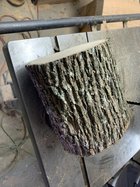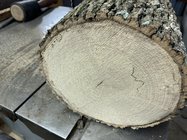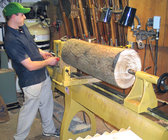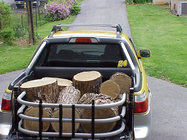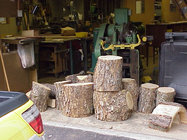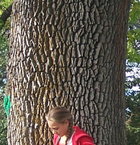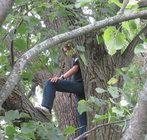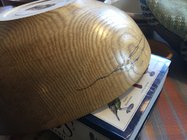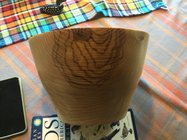-
It's time to cast your vote in the December 2025 Turning Challenge. (click here for details) -
Congratulations to Pat White for "Sicilian Mosaic" being selected as Turning of the Week for December 29, 2025 (click here for details) -
Welcome new registering member. Your username must be your real First and Last name (for example: John Doe). "Screen names" and "handles" are not allowed and your registration will be deleted if you don't use your real name. Also, do not use all caps nor all lower case.
You are using an out of date browser. It may not display this or other websites correctly.
You should upgrade or use an alternative browser.
You should upgrade or use an alternative browser.
Wood id help
- Thread starter Barry Holman
- Start date
I think it is Linden wood aka BasswoodCan someone help me identify this wood? To me the bark looks like a hardwood tree but the wood itself is soft. Any ideas? I View attachment 47280View attachment 47281View attachment 47282turned a vase from it and it felt like soft wood.
Bark looks like Linden/Basswood, a soft hardwood,
Thanks!
Basswood is diffuse porous. That doesn't look diffuse porous to me, much stronger ring porous. I'd say it looks more like ash, but I don't see any heart wood color. Sorry, I don't have a guess.
Paulonia ±
Bob
I always wondered about turning logs like that. Doesn’t the finished piece split because of the pith?
I always wondered about turning logs like that. Doesn’t the finished piece split because of the pith?
Realizing that's not always possible, having leaves from the tree makes identification infinitely easier.
Last edited:
With 95% of woods. that would split wide open after drying but paulonia is one of those trees that has extremely good manners about not getting drying checks.Bob
I always wondered about turning logs like that. Doesn’t the finished piece split because of the pith?
My son turned that in 2004 and it's still good.
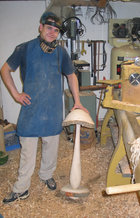
Nice piece!!The wood is sort of like catalpa but the bark is a little rougher than the catalpa samples I've run across.
View attachment 47286
View attachment 47287
And...is that a Subaru Brat hauling that wood? If so, i'm impressed!!
My guess is white ash that has been dead for a while. I turned a candle stick holder and the grain looked identical to that and the bark looked like that. The tree I got was killed by emerald ash borer. The wood was softer than oak. I agree that the bark sort of looks like basswood also.Can someone help me identify this wood? To me the bark looks like a hardwood tree but the wood itself is soft. Any ideas? I View attachment 47280View attachment 47281View attachment 47282turned a vase from it and it felt like soft wood.
Barry, looks like Ash to me. I get a lot of it and the bark is a match. The wood being soft may be due to it spalting and getting a bit punky.
A Subaru Brat it is. My brother in law had it. He passed away so now it is one of my nephew's most prized possession from his dad's legacy. The photos were taken in July of 2003. They had cut down a bit catalpa tree. That is one of the smelliest wood I've ever worked. Also, it made the tile floor greasy slick. I roughed out that lot into bowl blanks (rough turned bowls). I only took a few to finish.My guess is white ash that has been dead for a while. I turned a candle stick holder and the grain looked identical to that and the bark looked like that. The tree I got was killed by emerald ash borer. The wood was softer than oak. I agree that the bark sort of looks like basswood also.
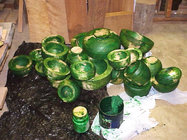
That's a lot of sealer for catalpa. Nothing dries as easily and quickly as catalpa. Never had a piece crack during storage or drying.A Subaru Brat it is. My brother in law had it. He passed away so now it is one of my nephew's most prized possession from his dad's legacy. The photos were taken in July of 2003. They had cut down a bit catalpa tree. That is one of the smelliest wood I've ever worked. Also, it made the tile floor greasy slick. I roughed out that lot into bowl blanks (rough turned bowls). I only took a few to finish.
View attachment 47294
The bark of basswood and black ash are very similar and many times are hard to tell one from the other. I live in a very rural part of northern Minnesota at the end of the maintained roads where most of the land to the north of my property is tax forfeited forest land it contains both basswood and ash together where if the leaves have fallen it is difficult to tell one from the other. The turned piece could never be mistaken for basswood and also the end grain on the cross cut logs show the ring porous feature that is not a part of basswood.Can someone help me identify this wood? To me the bark looks like a hardwood tree but the wood itself is soft. Any ideas? I View attachment 47280View attachment 47281View attachment 47282turned a vase from it and it felt like soft wood.
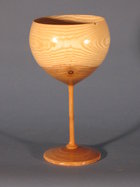
Picture this ash ( the tree had compound pinnate leaves) goblet with a stain that would darken open porous grain similar to the turned piece then compare it to a basswood carving block and the only conclusion is it is ash.
I'm with Randy. It's spalted, so you can't use hardness as an indicator of what wood it it.
It was my first time with catalpa. At the time I didn't know it was that stable. I treated it like any other wood. I know to avoid that species now. Live and learn.That's a lot of sealer for catalpa. Nothing dries as easily and quickly as catalpa. Never had a piece crack during storage or drying.
Barry's sample log looks like it grew extremely fast like catalpa and paulonia. It could be a trash tree that got out of hand like a paradise.
The turned piece is clearly ring porous like ash, but there are so many ring porous species that look like that.
Ash
- Joined
- Jul 18, 2018
- Messages
- 1,353
- Likes
- 2,932
- Location
- Baltimore, MD
- Website
- loujacobswoodturning.com
- Joined
- Jul 18, 2018
- Messages
- 1,353
- Likes
- 2,932
- Location
- Baltimore, MD
- Website
- loujacobswoodturning.com
My first thought was ash. Bark looks right. Not catalpa as the smell would give it away, and I do not like that smell. Ash is not really hard, but not soft. Big old ash trees can have brown heart wood, and that color just flies off of the shelf. I also did some where I had been finishing some walnut, and the dust from the walnut highlighted the pores like the picture you have. Once it gets into those pores, you can not get it out, but I didn't want to anyway. No clue about basswood. One of my sisters was an interpreter for a wild life sanctuary out side Kansas City. She had a basswood tree that went down and asked me what to do with it. I told her to try to find some carvers in the area. She got back to me and said, 'they took every single piece of it'.
robo hippy
robo hippy
Thanks Lou, no the Early and Late wood are the two parts of the yearly growth rings, where the Early growth wood is the fast growth of the spring and the Late wood is the slow growth of the summer/fall wood, shown in the picture below, the darker heartwood is usually a result of mineral take-up where some trees of the same species can have darker wood area and others are light all throughout.Leo, where you say latewood, do you mean heartwood? I’ve cut plenty of ash, including the bowl above, with only near white heartwood as well as sapwood, although most of what I get does have brown heartwood like this one View attachment 47309
The 2 pictures of the White Ash bowls let you see that some have the darker wood and the others are completely light, all because of where they grew.
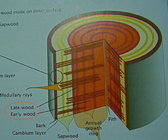
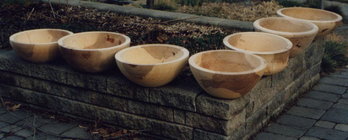

- Joined
- Jul 18, 2018
- Messages
- 1,353
- Likes
- 2,932
- Location
- Baltimore, MD
- Website
- loujacobswoodturning.com
Leo, I understand spring wood and summer wood. I was only asking because I think of ash as having pretty uniform color across the grain, as opposed to something like some of the oaks, or perhaps locust or Osage orange. Density of cells is another matter. But thanks for your clarification.
I've worked ash that was half the weight of other ash. There are something like 45 genus in the Ash family. Density is kg/cubic meter
| Ash, white | 650 - 850 |
| Ash, black | 540 |
| Ash, European | 710 |
Yes not all the same species do have the same weight, I bet spalted Linden would weight less than 1/3 of White Ash, as solid Linden can be 1/2 the weight of White Ash.I've worked ash that was half the weight of other ash. There are something like 45 genus in the Ash family. Density is kg/cubic meter
Ash, white 650 - 850 Ash, black 540 Ash, European 710
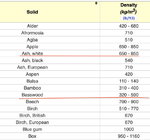
I’ve turned ash before and do not believe it’s ash. Freshly cut live tree, doubt spalting.Barry, looks like Ash to me. I get a lot of it and the bark is a match. The wood being soft may be due to it spalting and getting a bit punky.
- Joined
- Jul 18, 2018
- Messages
- 1,353
- Likes
- 2,932
- Location
- Baltimore, MD
- Website
- loujacobswoodturning.com
I believe the black lines in the cross section on your original post are spalting.
If you want to know for sure, send a chunk to the USDA forest products lab. They will analyze it and give you a written report for free. Instructions on their web site
Can someone help me identify this wood? To me the bark looks like a hardwood tree but the wood itself is soft. Any ideas? I turned a vase from it and it felt like soft wood.
Ash is what they make baseball bats out of. It is anything but soft. If I were to look at that and was told it was ash, I'd believe it since it looks enough like ash. Maybe I'll take a look the next time I'm up 29
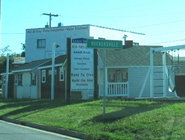
I just read somewhere in the last couple days that not 1 ash bat was used in the major leagues this past season, Ash bats are a thing of the past.
- Joined
- Feb 28, 2021
- Messages
- 1,778
- Likes
- 1,592
- Location
- Roulette, PA
- Website
- www.reallyruralwoodworks.com
I'd have to agree with Ash - I have a sizable pile of ash logs that look exactly like the O.P. If it is soft I'd say because it's been a dead tree - a lot of the ash that was cut down (that I salvaged some of the logs from) was already dead, and chainsaw cut through some spots like it was cutting air.
Two of the best wood identifiers on the internet can be found hanging out on Woodbarter.com. Just be prepared to post a sanded and magnified pic of the end grain. Anyone who is a woodworker can join at no cost. WB is a great place to find unusual turning wood, or just talk about anything wood working related. Great sister site to AAW If you’re addicted to wood.


